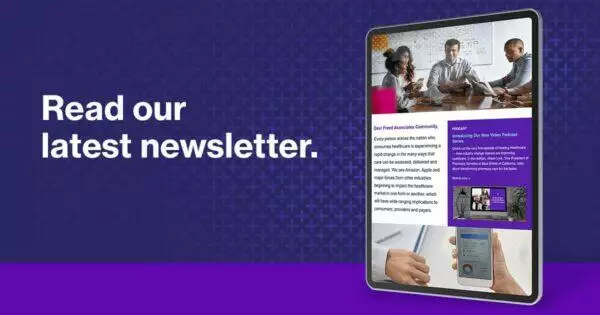Leveraging Technology to Enhance Population Health Efforts
How can you cost-effectively and efficiently harness technology to improve your population health efforts? When leveraging technology to enhance population health efforts, use technology solutions that keep patients at the center of your analysis and actions. Here are five technology best practices and five people-centric best practices to help guide your technology-driven population health efforts.

How can you cost-effectively and efficiently harness technology to improve your population health efforts? It’s a common question, as technology is the enabler for population health initiatives, yet many providers appear to be stalled or stymied in their attempts.
For instance, according to a recent study, nearly two-thirds of hospitals and health care providers have adopted remote patient monitoring and analytics into their care processes. However, they are struggling to integrate this information into their clinical workflows and at the desired frequency to support clinical decision-making and identify population health outreach opportunities.
It’s certainly not for a lack of interest among health care providers, as population health ties directly into their desire to provide optimal care for their communities. The problem is that it’s incredibly challenging to consolidate the massive amounts of data needed to improve population health and simultaneously devise a nimble technology platform to support it. Use the following best practices to help guide you.
Five Technology Best Practices
When leveraging existing data to get your population health program started, use technology solutions that keep patients at the center of your analysis and look for data enrichment opportunities within the following five technology best practices:
1. Think “big picture” technology roadmap—Look for technology solutions that maximize your system’s electronic health record (EHR) and downstream clinical applications’ integration and leverage the EHR’s data model. However, you will also need to consider a “big picture” roadmap that delivers a population health technology platform capable of exploiting unstructured “big data” and structured data. This roadmap may include some or all of the following:
- Data Sources
- Social data
- Streaming device data
- SMS/text patient communications
- Genetic-based patient data
- Segmented market data, geographic information system (GIS) data
- Internet of Things (IoT) data, via telematics and 5G networks
- Patient-provided data such as wearable devices and external streaming device
- Home devices
- Physiological monitors
- Smart pumps
- Radio-frequency identification (RFID)
- Platforms
- Enterprise data warehouse
- Data lake
- Big data cloud strategy
- Tools
- Data visualization
- Data mining
- Predictive and prescriptive analytics
- Business Intelligence
Considering the above list of emerging technologies and data sources and the drive to capture real-time data feedback, it is likely your population health platform will be a combination of technologies that address structured and unstructured data capture and storage wrapped into data governance processes. There is no one-platform technology that can encompass such diverse data management needs and objectives. Therefore, exercise caution locking into single-vendor solutions, so that you can be flexible with strategic changes requiring new data capabilities. Remember to keep your specific population health problems and objectives in mind as you evaluate how technology will support your solutions. Leverage research and information available on websites, such as data.gov and health care professional organizations, to assist with technology strategies that enable your organization to capture and share your data with other health care partners.
2. Create a data management foundation with data governance and metadata standards—The “data lake” concept has become popular, in which data is captured but not run through an extract, transform and load (ETL) process. While a data lake offers architectural advantages—primarily a more nimble platform for data capture—it still requires a metadata strategy so that analysts will know how to find the data. Hence, what you need is a data governance process to support your metadata. The advantages of establishing a data management foundation include capturing the sources of many different kinds of data, and focusing on back-end analytical processes and tools to exploit this data. However, you may still require a metadata strategy beyond mere indexing in order to exploit data insights and to develop predictive and prescriptive analytics capabilities. The Data Management Association’s Body of Knowledge is a compilation of data management principles and best practices and an excellent data management framework to support this endeavor.
3. Institute sufficient data profiling—Data profiling, also called data archeology, is the statistical analysis and assessment of data values within a data set for consistency, uniqueness and logic. Here is an opportunity to develop organizational data profiling capabilities, particularly based on these two realities:
- Data variability and inconsistency—It would be wonderful if all health care data could be captured consistently and reliably, but we know better, as clinical data arrives in both structured and unstructured formats. Providers often document such data in ways that may fit their immediate clinical needs but down the road, these habits often stymie attempts to aggregate and analyze this data in a consistent fashion. The technical solution will depend on effective organizational data management and tools to standardize data or prevent corrupt data from clouding analytical results. Data profiling can identify important business rules for data conformance.
- Data collection variability—Data profiling can help evaluate the best sources for your data. Consider the variety of patient touchpoints in a typical clinical setting, ranging from ER to radiology to pharmacy, as well as variabilities in data source systems and formats. Data profiling supports ETL tools to organize and conform this disparate data into a single, central system to make it understandable and actionable.
4. Evaluate technology needs and advances—Your health technology roadmap presents an ideal opportunity to consider your long-term technology needs. Now may be a wise time to consider using the services of an experienced health technology consultant who can advise you on ensuring that your organization has the tools it needs. Some leading questions:
- Does your organization have the right set of technologies to generate the data your population health efforts require?
- What potential technology-related barriers lie ahead, based on your systems and their interoperability, and how can you tell if there are any negative surprises ahead?
- What’s ahead in integration technology? For example, consider the learnings available from the “Fast Interoperability Health Resource” (FHIR) from Health Level Seven International® (HL7), which may become the new application programming interface (API) for health care.
- What are your advanced analytics needs and capabilities? For example, these could include “suggestive analytics” for physicians.
- How can data be more visual and meaningful? For example, there are now electronic medical record (EMR) “wrapper” applications that can draw out data more visually and meaningfully. Research shows there are approximately 100 most common order sets that physicians use in their EMR; is there an opportunity to develop “smart notices” about patients that focus on these?
5. Ensure sufficient population health data storage—Consider using a data warehouse to manage population health data. There are population health management applications, and now major EHR vendors are stepping up with population health management applications. Consider a pilot approach to explore their capabilities and benefits. Bearing in mind the technology is emergent and quickly evolving, these solutions will provide a foundational data warehouse for population health. A data lake architecture may accommodate a data warehouse and unstructured big data sources. The strategy aspect of this architecture work typically requires consulting support from architecture solution experts for many health care provider and plan organizations.
Five People-Centric Best Practices
In addition to the technology-specific best practices listed above, you should also consider the following best practices related to the people who will be interacting with and using your technologies. Here are five people-centric best practices:
1. Tailor your initiative to your specific community needs—Rigorously determine your specific community’s most pressing health care needs and work backward from those information requirements. The data points required by one organization to meet its population health needs may be completely different than those which are most needed by your organization. Asking the right questions of your community will result in the best match for your technology solutions.
2. Align with patient engagement efforts—Assess how tools such as telemedicine and mobile device technologies can positively benefit your population health efforts and help drive patient engagement, as well as enrich your population health data with patient-provided data about their condition and satisfaction with the quality of care. Increasingly, tools that support patient participation with their health care are being found to beneficially influence patients’ behaviors. This implies a technology strategy that anticipates an ever-increasing need to coordinate the use of such devices within your care coordination systems framework, and correspondingly within your population health efforts.
3. Partner trained data management professionals—clinical, business and IT—with your physician leaders—Together, these professionals should identify your organization’s required data and population risk stratification scenarios. This approach will more likely generate the right types and amounts of data needed to provide the decision-making information necessary for your initiative.
4. Determine analytical roles & skills—Gauge the training investment needed with the complexity of the proposed health management technology. Technologies are only as good and as useful as the people who operate them. Consider the needs to get your clinical informaticists and business subject matter experts up to speed.
5. Consider using a population health vendor—Short term, you may wish to consider a strategic population health vendor partnership or another health system partner. Many health care organizations, particularly those serving rural communities, lack the IT infrastructure and staff needed to gather the required population health data and transform it into actionable information. Organizations with larger budgets to spend on leading-edge health care information technology, and the ability to gain economies of scale in their purchasing, will automatically have a head start on using technology to drive their population health needs.
Think Incrementally
Building a roadmap for your population health technology is complex. Given the emerging technologies, your roadmap will change course as you progress toward having the solid data management foundation you need. Revisit your roadmap to ensure you are:
1. Considering the most current technology.
2. Following your data management strategy.
3. Using well-trained resources.
4. Asking the right questions about the population health needs in your communities.
These guidelines will help you constantly improve your analytics capabilities and harness the ever-growing amount of data.
Link to Published Article (may require registration)
http://www.healthcare-informatics.com/article/population-health/leveraging-technology-enhance-population-health-efforts

